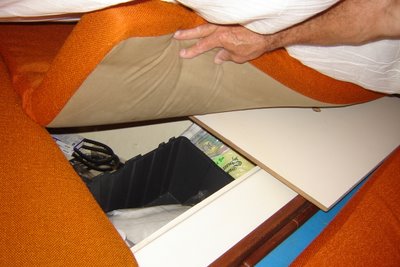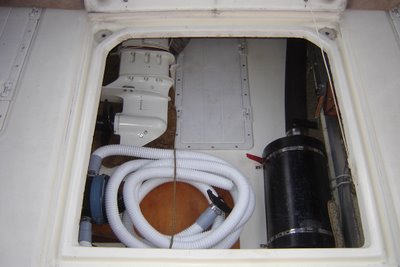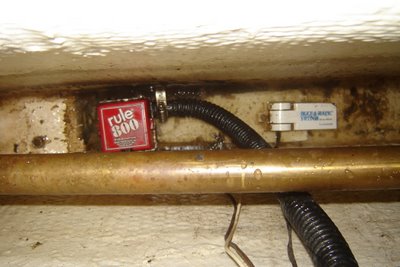This description is of a 1986 Sports Cruiser with its large open aft cockpit – and many variations preceded & followed our set up. Of course, the Family Cruiser - the aft cabin model has different set ups & access.
AlbinCruisers Information
This website posts advertisements & reports on Albin 25 & 27 cruisers & information on fitting out “Drifter” (A27SC86 - Sault Ste. Marie, 0n. Nissan LD28 - 78hp) for extended cruising – it’s our “summer cottage”. To get to a topic in the List of Posts, check the date of posting & click on the date in the Archives & scroll down the posting. Comment on a post by clicking the icon below the post - I get a copy by email. To get a reply include your email address. John
Tuesday, September 26, 2006
A Boat of Many Bilges
This description is of a 1986 Sports Cruiser with its large open aft cockpit – and many variations preceded & followed our set up. Of course, the Family Cruiser - the aft cabin model has different set ups & access.
This description is of a 1986 Sports Cruiser with its large open aft cockpit – and many variations preceded & followed our set up. Of course, the Family Cruiser - the aft cabin model has different set ups & access.

The next compartment – under the engine & an extension of the engine compartment- contains the secondary bilge pump. It is located at the bottom of the cavity formed by the keel. Getting to it around the shaft will test the working range of your joints. The pump & float switch are mounted on a loose plywood base – to allow retrieval from the pit for repair & maintenance. Be sure that the pump is wired so that it is always "on" with the battery switches "off". Some boats have it miswired, so this precaution s not as strange as it sounds. Of course there is a panel switch so that one can turn the pump on manually.
The stuffing box or stern gland is water lubricated & should be adjusted to drip once every 30 to 45 seconds.
STUFFING BOX ADJUSTMENT
A satisfactory lowing of the “drip rate” can usually be achieved by tightening the stern gland packing. Use a ball peen hammer to loosen the locking nut (the aft of two six flatted nuts). Facing aft, strike a flat on the locking nut at the three o'clock position, on the port side, to turn it down (clockwise). When it moves a bit, take a few more turns clockwise by hand. Then, use a wrench to turn the packing gland nut (the forward of the two six flatted nuts) in the same direction (clockwise) a quarter or half turn, or more, or until considerable resistance is felt, until snug or the drip stops, then slightly more. Turn the locking nut counter clockwise by hand until it contacts the gland nut, then strike an edge of a flat a couple of hits with the hammer to seat it against the packing gland nut. With a bit of experience, the whole operation is perhaps 30 seconds of contortion.
Since the gland nuts are in very confined space a custom made wrench appears to be necessary. One readily available alternative is a chain wrench - they have an adjustable chain that wraps around almost anything & a "vice-grip" like tightening mechanism. By loosening & tightening you can use it like a ratchet in very tight places. Easier than making a special tool & has other applications as well.
STUFFING BOX REPACKING
If the packing gland nut is already so tight & can’t be turned it is time to add another turn of packing or replace all of it with 5/16 Gore-Tex (preferably while the boat is out of the water). Clean up the threads & shaft with mineral spirits. Loosen the locking nut, unscrew the packing gland & slide it forward on the shaft Remove the old packing with a Flax Pic, check with a mirror that all has been removed& cut new packing the same length. Insert new rings one at a time alternating joints & pack each in with the gland. When packed full (about ¼” thread remaining), tighten the packing nut & lock nut.
DRAIN PLUG
Later models of the27s have a winter drain plug. If SC version, you can see the plug if it is there down in the bottom of the keel somewhere around the bilge pump. If an AC, you are on your own. Often there is enough bottom paint accumulation so that the plug may be hard to find from the outside. A 3/8" or 1/2" drive ratchet should fit the drain plug. Use NEVER-SEIVE (anti-seize) on the threads to facilitate removal
For example the1990 Albin 27 Express came had a bilge drain plug on the port side of the keel exactly 26 inches forward of the after end of the keel (not counting the skeg). It is about one inch above the bottom of the keel. It has a female fitting that is one half inch square so a standard socket wrench handle fits.
The purpose of the keel drain is to help remove the various kinds of crud from the bilge. After draining, follow up with nice fresh water flush. Follow that with a vacuum job. If you need to add one the best location is the lowest place in the bilge. The hole must be drilled from the outside, so careful measurement is needed. The plug is about 1 1/2" in diameter with a large 5/8" square hole in the centre. It fits flush so that nothing will catch on it.
Finally, there is a compartment accessed by a hatch in the aft end of the cockpit that contains the rudder post.















